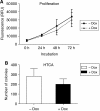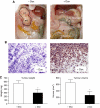Inducible re-expression of p16 in an orthotopic mouse model of pancreatic cancer inhibits lymphangiogenesis and lymphatic metastasis
- PMID: 18577984
- PMCID: PMC2453030
- DOI: 10.1038/sj.bjc.6604457
Inducible re-expression of p16 in an orthotopic mouse model of pancreatic cancer inhibits lymphangiogenesis and lymphatic metastasis
Abstract
Functional inactivation of the tumour suppressor protein p16(INK4a) constitutes a key event in the multistep process of pancreatic ductal cell transformation. However, the significance of p16 inactivation for complex and tissue-specific aspects of pancreatic cancer progression, such as angiogenesis and metastasis, is less understood. Here, we inducibly re-expressed p16 in vivo in an orthotopic model of pancreatic cancer and examined the impact on these clinically relevant aspects of pancreatic cancer tumour biology. Consistent with previous work in subcutaneous xenograft models, we found p16 capable of reducing primary tumour growth. In addition, p16 restitution resulted in a marked reduction of tumour angiogenesis, largely accounted for by a p16-dependent inhibition of lymphangiogenesis. In excellent agreement with the antilymphangiogenic effect, re-expression of p16 almost completely prevented lymph node metastases of MiaPaca-2 pancreatic tumours. To our knowledge, this is the first report that experimentally links the tumour suppressor p16 to the process of lymphangiogenesis.
Figures






Similar articles
-
The proline TP53 variant stimulates likely lymphangiogenesis in an orthotopic mouse model of pancreatic cancer.Br J Cancer. 2012 Jan 17;106(2):348-57. doi: 10.1038/bjc.2011.521. Epub 2011 Dec 6. Br J Cancer. 2012. PMID: 22146521 Free PMC article.
-
Vascular endothelial growth factor-D induces lymphangiogenesis and lymphatic metastasis in models of ductal pancreatic cancer.Int J Oncol. 2005 Sep;27(3):669-79. Int J Oncol. 2005. PMID: 16077915
-
Combined targeting of TGF-β, EGFR and HER2 suppresses lymphangiogenesis and metastasis in a pancreatic cancer model.Cancer Lett. 2016 Aug 28;379(1):143-53. doi: 10.1016/j.canlet.2016.05.037. Epub 2016 Jun 3. Cancer Lett. 2016. PMID: 27267807 Free PMC article.
-
Clinical Effect of Driver Mutations of KRAS, CDKN2A/P16, TP53, and SMAD4 in Pancreatic Cancer: A Meta-Analysis.Genet Test Mol Biomarkers. 2020 Dec;24(12):777-788. doi: 10.1089/gtmb.2020.0078. Genet Test Mol Biomarkers. 2020. PMID: 33347393
-
Update on familial pancreatic cancer.Adv Surg. 2010;44:293-311. doi: 10.1016/j.yasu.2010.05.011. Adv Surg. 2010. PMID: 20919528 Free PMC article. Review. No abstract available.
Cited by
-
Up-regulation of p16 by miR-877-3p inhibits proliferation of bladder cancer.Oncotarget. 2016 Aug 9;7(32):51773-51783. doi: 10.18632/oncotarget.10575. Oncotarget. 2016. PMID: 27429046 Free PMC article.
-
The lymphatic system and pancreatic cancer.Cancer Lett. 2016 Oct 10;381(1):217-36. doi: 10.1016/j.canlet.2015.11.048. Epub 2015 Dec 29. Cancer Lett. 2016. PMID: 26742462 Free PMC article. Review.
-
Molecular Drivers of Pancreatic Cancer Pathogenesis: Looking Inward to Move Forward.Int J Mol Sci. 2017 Apr 6;18(4):779. doi: 10.3390/ijms18040779. Int J Mol Sci. 2017. PMID: 28383487 Free PMC article. Review.
-
RhoT1 and Smad4 are correlated with lymph node metastasis and overall survival in pancreatic cancer.PLoS One. 2012;7(7):e42234. doi: 10.1371/journal.pone.0042234. Epub 2012 Jul 31. PLoS One. 2012. PMID: 22860091 Free PMC article.
-
The proline TP53 variant stimulates likely lymphangiogenesis in an orthotopic mouse model of pancreatic cancer.Br J Cancer. 2012 Jan 17;106(2):348-57. doi: 10.1038/bjc.2011.521. Epub 2011 Dec 6. Br J Cancer. 2012. PMID: 22146521 Free PMC article.
References
-
- Ahmed SA, Gogal Jr RM, Walsh JE (1994) A new rapid and simple non-radioactive assay to monitor and determine the proliferation of lymphocytes: an alternative to [3H]thymidine incorporation assay. J Immunol Methods 170: 211–224 - PubMed
-
- Alves F, Contag S, Missbach M, Kaspareit J, Nebendahl K, Borchers U, Heidrich B, Streich R, Hiddemann W (2001) An orthotopic model of ductal adenocarcinoma of the pancreas in severe combined immunodeficient mice representing all steps of the metastatic cascade. Pancreas 23: 227–235 - PubMed
-
- Bardeesy N, Aguirre AJ, Chu GC, Cheng KH, Lopez LV, Hezel AF, Feng B, Brennan C, Weissleder R, Mahmood U, Hanahan D, Redston MS, Chin L, DePinho RA (2006) Both p16(Ink4a) and the p19(Arf)-p53 pathway constrain progression of pancreatic adenocarcinoma in the mouse. Proc Natl Acad Sci USA 103: 5947–5952 - PMC - PubMed
-
- Blouw B, Song H, Tihan T, Bosze J, Ferrara N, Gerber HP, Johnson RS, Bergers G (2003) The hypoxic response of tumors is dependent on their microenvironment. Cancer Cell 4: 133–146 - PubMed
Publication types
MeSH terms
LinkOut - more resources
Full Text Sources
Medical

